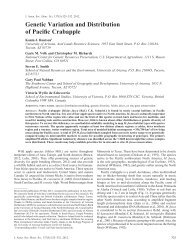CONSERVATION
Conservation You Can Taste - The Southwest Center - University of ...
Conservation You Can Taste - The Southwest Center - University of ...
- No tags were found...
You also want an ePaper? Increase the reach of your titles
YUMPU automatically turns print PDFs into web optimized ePapers that Google loves.
Pueblo Indians that Navajo raiders began to capture them<br />
and establish their own flocks. Essentially, the sheep soon<br />
became central to the creation stories of the Diné (Navajo) and<br />
cherished in the material culture of Hopi, Zuni and Hispanic<br />
herders in the Four Corners region. Tragically, Navajo-Churro<br />
flocks were nearly decimated twice over the last century and<br />
a half; regardless, the Churro were still esteemed by Hispanic<br />
and Navajo herders and weavers who did not let the memory<br />
of this distinctive breed disappear from their oral histories or<br />
their livelihood.<br />
When the livestock research program at Fort Wingate, NM<br />
closed in 1965 the last known 800 ewes and 20 rams of the<br />
breed were sold off all over the west and most were killed and<br />
eaten. Fortunately, within a just a few years of that catastrophe<br />
two talented observers of livestock—wool producer Ingrid<br />
Painter and livestock scientist Dr. Lyle McNeal—discovered<br />
the remnants of those flocks and recognized their uniqueness.<br />
Ingrid began to raise them to share with other wool producers.<br />
Lyle and his wife Nancy established the Navajo Sheep Project<br />
to research their distinctive characteristics, genetically restore<br />
the quality of the breed’s remaining sheep, and return them to<br />
the Navajo people. Around 1977 Dr. McNeal also linked the<br />
Navajo Sheep Project’s efforts to the recently founded American<br />
Minor Breeds Conservancy, which offered technical assistance<br />
on the conservation breeding of endangered populations.<br />
As the McNeals brought the traditional genetics of the<br />
breed back into order, 17 Navajo weavers took advantage<br />
of the renewed availability of Navajo-Churro wool and meat<br />
forming a non-profit called Diné Be’iiná, which began to<br />
host annual Sheep is Life gatherings on Navajo Nationlands.<br />
When similar efforts developed among Hispanic weavers<br />
near Tierra Amarilla and on the Zuni Indian reservation these<br />
groups decided to join forces collectively forming the Navajo-<br />
67



